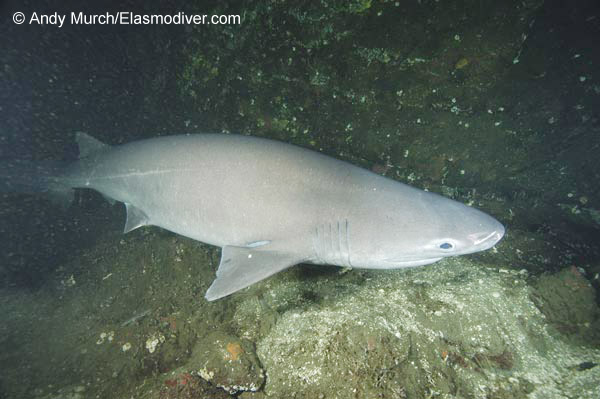| Hexanchidae (Cow sharks) |
| 482 cm TL (male/unsexed); max.weight: 590 kg |
|
bathydemersal; depth range 1 - 2500 m, oceanodromous |
| Circumglobal: In tropical and temperate waters; (Ref. 13573). Western Atlantic: North Carolina to Florida (USA) and northern Gulf of Mexico to northern Argentina. Eastern Atlantic: Iceland and Norway to Namibia, including the Mediterranean. Indian Ocean: Madagascar, Mozambique, South Africa, and Arabian Sea (Ref.85183). Western Pacific: eastern Japan to New Zealand and Hawaii. Eastern Pacific: Aleutian Islands, Alaska to Baja California, Mexico; also Chile . Highly migratory species, Annex I of the 1982 Convention on the Law of the Sea (Ref. 26139, Ref. 41819). |
|
Dorsal spines (total): 0-0; Dorsal soft rays (total): 0-0; Anal spines: 0-0; Anal soft rays: 0-0. A heavily-bodied, broad-headed sixgill shark, mouth ventral with 6 rows of lower, bladelike, comb-shaped teeth on each side (Ref. 247). Snout broadly rounded, body fusiform (Ref. 6871). Anal fin smaller than dorsal fin (Ref. 6871). Brown or grey above, paler below, with a light stripe along side (Ref. 26346). Fins with white edges (Ref. 6574). Live specimens with fluorescent green eyes (Ref. 6871). Six gill slits are very long (Ref. 35388). |
| Depth range reported at 0m-2000m. A deepwater species of the outer continental and insular shelves and upper slopes (Ref. 6871). Near bottom, occasionally pelagic, adults usually below 91 m (Ref. 58302). Juveniles may be found close inshore (Ref. 6871). Found on the bottom by day, moving to the surface at night to feed, and where it may take longlines set for other species (Ref. 45445). Depth distribution related to growth and temperature, with juveniles having most shallow records and from colder, poleward regions (Ref. 58302). Feeds on a wide range of marine organisms, including other sharks, rays, chimaeras, bony fish, squids, crabs, shrimps, carrion, and even seals. Ovoviviparous (Ref. 205), with 22 to 108 pups in a litter (Ref. 247). Marketed fresh, frozen, or dried salted; also utilized as a source of oil and fishmeal. Not known to have attacked people without provocation (Ref. 247). Give birth to almost 100 young (Ref. 35388). |
|
Near Threatened
(Ref. 96402)
|
| poisonous to eat |
|
Source and more info: www.fishbase.org. For personal, classroom, and other internal use only. Not for publication.
Page created by Jen, 05.08.02,
php script by kbanasihan 06/09/2010 ,
last modified by
dsantos, 20/08/10

